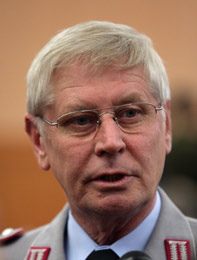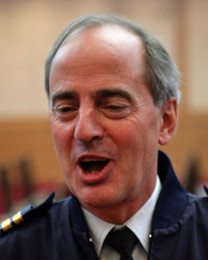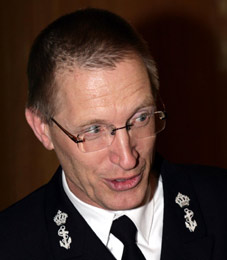Policy remains purely defensive
(China Daily)Updated: 2006-12-30 07:11
Building a harmonious world : China pursues peaceful development, and endeavours to build, together with other countries, a harmonious world of enduring peace and common prosperity.
Joint operational capability : The People's Liberation Army (PLA) focuses on enhancing joint training to improve the integrated joint operational capabilities of various services and arms. It gives priority to the training of joint campaign commanders and command organs, joint field exercises and the training of different support forces in integrated support.
|
|
| I
found that the military expenditure is becoming more transparent in the
White Paper. The more facts and figures we get on China's defence policy,
the safer we will feel. Colonel Hans-Klaus Haacke Defence Attach of Germany |
|
|
| We
can see Chinese economic development is boosting its military building
modernization, and we appreciate its self-defensive policy for peaceful
development. Colonel Ken Sorfleet Defence Attach of Canada |
|
|
| What
I am interested most in this paper are the chapters on military strategy.
The White Paper gives me a chance to make some judgments on many important
issues such as where the military expenditure is going. Wim J.P. Klaas Naval Attach of the Netherlands |
|
|
Chinese military expenditure mentioned in this paper is very suited to China's defence needs. There is no reason for other nation to be concerned about it, since it is only for China's defence. Capt Foad Amin Naval Attach of Pakistan |
Purely defensive in nature
: China pursues a defence policy that is purely defensive
in nature. China's national defence, in keeping with and contributing to the country's development and security strategies, aims at maintaining national security and unity, and ensuring the realization of the goal of building a moderately prosperous society in an all-round way.
Combat troops and armed police : The PLA has 18 combined corps, which are mobile combat troops. The People's Armed Police Force (PAPF) has a total force of 660,000.
More challenges : China's security still faces challenges that must not be neglected. The growing interconnections between domestic and international factors and interconnected traditional and non-traditional factors have made maintaining national security a more challenging task.
The struggle to oppose and contain the separatist forces for "Taiwan independence" and their activities remains a hard one. By pursuing a radical policy for "Taiwan independence," the Taiwan authorities aim at creating "de jure Taiwan independence" through "constitutional reform," thus still posing a grave threat to China's sovereignty and territorial integrity, as well as to peace and stability across the Taiwan Straits and in the Asia-Pacific region as a whole.
Rational defence budget: Pursuant to the National Defence Law and the Budget Law, and guided by the principle of coordinated development of national defence and the economy, the Chinese Government decides on the size and use of defence expenditure in an appropriate way to meet the demands of national defence in keeping with China's economic development.
From 1979 to 1989, the average annual increase of defence expenditure was 1.23 per cent. However, defence expenditure actually registered an average annual decrease of 5.83 per cent, given the 7.49 per cent average annual increase of the consumer price index in the same period.
From 1990 to 2005, the average annual increase in defence expenditure was 15.36 per cent. As the average annual increase of the consumer price index during the same period was 5.22 per cent, the actual average increase in defence expenditure was 9.64 per cent.
Armed with information technology: China pursues a three-step development strategy in modernizing its national defence and armed forces, in accordance with the State's over-all plan to realize modernization.
The first step is to lay a solid foundation by 2010, the second is to make major progress around 2020, and the third is to basically reach the strategic goal of building informatized armed forces and being capable of winning informatized wars by the mid-21st century.
Downsizing the PLA: The Army was the focus of force reduction, and its authorized number of personnel has been reduced by more than 130,000. Over 60,000 military personnel have been removed from the headquarters and directly affiliated units of military area commands and provincial military commands. Through restructuring, the proportion of the Navy, Air Force and Second Artillery Force in the PLA has been raised by 3.8 per cent while that of the Army has been lowered by 1.5 per cent.
In 1985, 1997 and 2003, China announced that it would cut the size of the PLA by 1 million, 500,000 and 200,000 persons, respectively. By the end of 2005, China had completed reducing the PLA by 200,000 troops, and the PLA currently has 2.3 million troops.
The Navy: The Navy is working to build itself into a modern maritime force consisting of combined arms with both nuclear and conventional means of operations.
Taking informatization as the goal and strategic focus in its modernization drive, the Navy gives high priority to the development of maritime information systems, and new-generation weaponry and equipment.
Efforts are being made to improve maritime battlefield capabilities, with emphasis on the construction of relevant facilities for new equipment and the development of combat support capabilities.
Artillery and air defence: The artillery and air defence component has fielded new types of cannons, field anti-aircraft missiles, reconnaissance early warning radars, fire-control systems, and intelligence and command systems, and increased the proportion of ground-to-air missiles to anti-aircraft guns.
The Air Force: The Air Force is working to build an informatized air fighting force with both offensive and defensive capabilities. It is reducing the number of combat aircraft, giving priority to the development of new fighters as well as air and missile defence weapons. It is working to enhance command and control systems.
The nuclear force: China upholds the principles of counterattack in self-defence and limited development of nuclear weapons, and aims at building a lean and effective nuclear force capable of meeting national security needs. It endeavours to ensure the security and reliability of its nuclear weapons and maintains a credible nuclear deterrent force.
China's nuclear force is under the direct command of the Central Military Commission (CMC). China exercises great restraint in developing its nuclear force. It has never entered into and will never enter into a nuclear arms race with any other country.
Salaries for service people: From July 1, 2006, salaries for service people have been increased by a wide margin.
International military ties: China has established military ties with over 150 countries and military attache offices in 107 countries. A total of 85 countries have military attache offices in China. Since 2002, China has held 16 joint military exercises with 11 countries.
Participation in UN peacekeeping: Since 1990, China has sent 5,915 military personnel to participate in 16 UN peacekeeping operations. Eight lost their lives and several dozens were wounded on duty.
New security concept: China pursues a new security concept featuring mutual trust, mutual benefit, equality and co-ordination, and adheres to the Five Principles of Peaceful Coexistence. It works to promote good-neighbourliness, mutual benefit and win-win, and endeavours to advance international security co-operation and strengthen military relations with other countries.
Policies on chemical weapons: China honours in good faith its obligations under the Chemical Weapons Convention. Since 2005, China has assisted Japan in 24 on-site verifications, and recovered over 3,100 chemical weapons abandoned by Japan.
Export control of weaponry: China has established a complete legal regime for controlling the export of nuclear, biological and chemical weapons, missiles and other related sensitive items and technologies, and all defence items. China follows strict procedures in approving exports, to ensure effective export control.
(China Daily 12/30/2006 page3)
|
||
|
||
|
|



